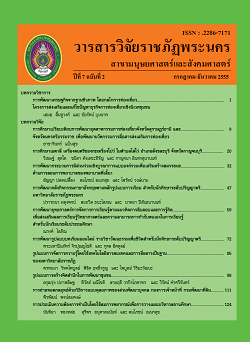การศึกษาเมตาลี่ เครื่องดนตรีของกะเหรี่ยงโปว์ ในตำบลไล่โว่ อำเภอสังขละบุรี จังหวัดกาญจนบุรี
Main Article Content
บทคัดย่อ
การศึกษาครั้งนี้มีวัตถุประสงค์ เพื่อศึกษาถึงประวัติความเป็นมาและองค์ประกอบต่าง ๆ ของเมตาลี่ รวบรวมและวิเคราะห์บทเพลงที่บรรเลงโดยเมตาลี่ ศึกษาบทบาทหน้าที่ของเมตาลี่ในวัฒนธรรมกะเหรี่ยงโปว์ โดยใช้วิธีการดำเนินการวิจัยตามหลักมานุษยดุริยางควิทยา ข้อมูลต่าง ๆ ที่รวบรวมได้ทั้งหมดมาจากการเก็บ ข้อมูลโดยการลงพื้นที่ภาคสนาม แล้วนำมาทำการศึกษาวิเคราะห์ เรียบเรียงความสำคัญ ผลการวิจัยพบว่า เมตาลี่เป็นเครื่องดนตรีประเภทดีดของกะเหรี่ยงโปว์ ในตำบลไล่โว่ สันนิษฐานว่าพัฒนามาจากเครื่องดนตรี ตะวันตกที่เรียกว่า “แมนโดลิน” เมตาลี่ที่พบในตำบลไล่โว่สามารถแบ่งได้ 2 ประเภท คือ 1.เมตาลี่แบบโปร่ง 2.เมตาลี่แบบกล่องเสียงอลูมิเนียม การแสดงเมตาลี่พบได้ทั่วไปในตำบลไล่โว่ โดยชาวกะเหรี่ยงให้ความสำคัญ และถือเป็นเครื่องดนตรีประจำชนเผ่าของตนเอง บทเพลงเมตาลี่ยังสื่อถึงความนึกคิดของชาวกะเหรี่ยง บางครั้งสะท้อนมุมมองด้านสังคม ธรรมชาติ ความเชื่อ และความรัก การสืบทอดในปัจจุบันพบน้อยมาก สาเหตุที่ขาดผู้สืบทอดมีหลายประการ เช่น ความยากในการร้อง และบรรเลงเมตาลี่ สภาวะทางเศรษฐกิจ การเปลี่ยนแปลงทางสังคมสมัยใหม่
การวิเคราะห์บทเพลงจำนวน 6 เพลง พบว่า โครงสร้างของบทเพลงไม่ซับซ้อน และสามารถบรรเลงซํ้า ได้ตามความพอใจ ในการบรรเลงแนวทำนองหลักจะเป็นทำนองเดียวกับทำนองร้อง และมีการเล่น สอดประสานเมื่อจบวรรคของทำนองร้อง กลุ่มเสียงหลักที่ใช้ ได้แก่ ดอเรียนโหมด เมเจอร์สเกล เพนทาโทนิก ไมเนอร์ และ ลิเดียนโหมด การเคลื่อนที่ของทำนองมี 3 แบบ คือ การเคลื่อนที่แบบต่อเนื่อง การเคลื่อนที่ แบบไม่ต่อเนื่อง และการเคลื่อนที่แบบซํ้าลักษณะเสียงเดิม มีการเล่นทำนองเสียงตํ่าพร้อมกับการดำเนินแนว ทำนองหลัก
The Matale, an instrument of the Pwo Karen in Laivo sub-district, Sangklaburi district, Kanchanaburi province
This research aimed to study the historical background and the elements of the Matale with the aim of identify the roles of the metale in the Pwo Karen culture. It followed the ethnomusicological research pattern. The data collection was performed through a field method. Then, the obtained data was analyzed, and organized by the order of importance. It was found that the metale was a string instrument of the Pwo Karen in Laivo sub-district, Sangklaburi district, Kanchanaburi province. It was assumed that the matale was developed from the mandolin, a western musical instrument. The metale found in this area could be divided into two kinds: (1) the acoustic metale and the acoustic aluminum metale. The metale performance was commonly found in this area. Considered its significance, the metale was deemed a tribal music instrument. Moreover, metale songs conveyed thoughts of the Karen people and reflected society, nature, beliefs, and love. However, the delivery of education about the metale to the next generation was hardly found for several reasons such as the difficulties in singing and in playing the metale, troubled economy, and the change to modern society.
The analysis of six matale songs indicated that the song structure was simple and catchy. Metale melodies often accorded with singing melodies. The improvisation was found at the end of the melodies. The major scales were a dorian mode, a major scale, a pentatonic minor, and a Lydian mode. Moreover, three kinds of melodic motions were found, namely conjunct motion, disjunct motion, and repletion motion. Also the bass simultaneously carried the melodies.
Article Details
บทความที่ได้รับการตีพิมพ์เป็นลิขสิทธิ์ของมหาวิทยาลัยราชภัฏพระนคร
ข้อความที่ปรากฏในบทความแต่ละเรื่องในวารสารวิจัยราชภัฏพระนครเล่มนี้เป็นความคิดเห็นส่วนตัวของผู้เขียนแต่ละท่านไม่เกี่ยวข้องกับมหาวิทยาลัยราชภัฏพระนคร และคณาจารย์ท่านอื่นๆในมหาวิทยาลัยฯ แต่อย่างใด ความรับผิดชอบองค์ประกอบทั้งหมดของบทความแต่ละเรื่องเป็นของผู้เขียนแต่ละท่าน หากมีความผิดพลาดใดๆ ผู้เขียนแต่ละท่านจะรับผิดชอบบทความของตนเองแต่ผู้เดียว


